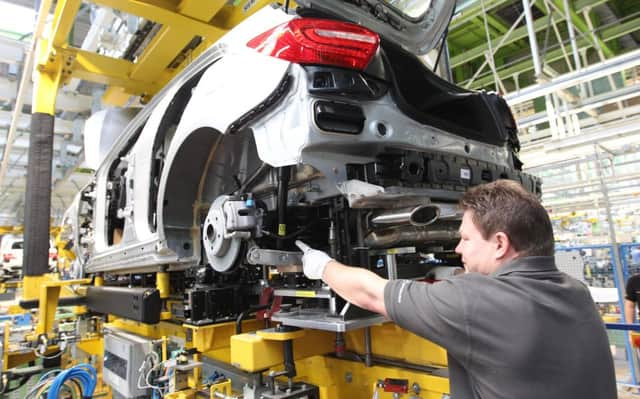Scott Macnab: What Scots can do to be nation of makers again


Scotland’s proud history as an industrial powerhouse which was once the envy of the world has been thrown into poignant focus over the past week. The shipbuilding legacy of the former John Brown’s yard in Clydebank was secured for posterity with a major regeneration project unveiled for the site, retaining the famous 800-tonne Titan crane as its centrepiece – a lasting memorial to the many great liners and warships it once helped to fit out.
For an older generation, the iconic yard recalls a time when heavy industry thrived in Scotland and tens of thousands worked in shipbuilding. But those memories turned painful as the UK steel industry was engulfed by a crisis which threatens its very survival. Echoes stirred of a time when another Conservative government presided over years of demise at the Ravenscraig works in Lanarkshire, which once employed more than 13,000 workers, until its final closure in 1992. It marked the end of one of the last remnants of an industry which had once stood at the heart of Scotland’s “real economy” throughout the 19th century and up to the post-war years.
Advertisement
Hide AdAdvertisement
Hide AdThe harsh reality is that Scotland is only escaping the dilemma faced by UK ministers over the looming steel closures because this country has already been through that heartache decades ago. The two remaining rolling plants at Dalzell and Clydebridge, recently saved from the axe, are relatively minor concerns. Scotland’s steel industry has largely disappeared, changing communities forever. The 1,000-acre site which once housed Ravenscraig is now largely derelict. A college, sports centre and some housing occupy a small part of the site, but development has been at a fraction of the scale once promised.
Similarly, shipbuilding has also fallen away from a peak of up to 70,000 workers in the 19th century to little more than a few thousand today. The coal industry which once produced 42 millions tonnes a year has now all but gone after the last deep mine closed at Longannet in 2002, while a once-significant car industry is no more.
In short, Scotland simply doesn’t make things any more. How many friends and family do you have working in factories? Not many, I’ll bet. Instead, employment has shifted to services. So we’re all likely to be working in hotels, restaurants of sitting in offices working for banks, maybe insurance firms. These are the drivers of Scotland’s new economy. There is nothing wrong with that, but whatever happened to the “march of the makers” hailed by George Osborne soon after taking over as Chancellor six years ago? Events of the past week have seen that pledge come back to haunt him.
And what’s left of Scotland’s manufacturing base is facing a bleak future. The sector recorded its sharpest fall in new orders for four years, while its employment declined at the fastest pace since the start of 2011, a survey carried out by the Confederation of British Industry recently found. Fewer than 200,000 of Scotland’s 2.5 million total workforce are now employed in making things to sell and, hopefully, export around the world - a key driver of future growth.
A spate of closures in the first few months of this year alone have seen hundreds of jobs go as major names like Texas Instruments in Greenock, Polaroid Eyewear in West Dunbartonshire and Muller dairies in Aberdeen and East Kilbride announced plans to close their doors. Nicola Sturgeon knows the problem is serious and set out plans in February for a joint Centre of Excellence for Manufacturing and Skills Academy to ensure Scotland can “compete globally”.
But the idea to bring together industrialists, universities, colleges and schools to ensure a more collaborative approach in making Scotland work has been tried elsewhere globally with varying degrees of success. It remains to be seen if the Scottish drive will prove a success. In fact, a damning report last week dismissed the prospect of making universities great powerhouses of economic growth through research and innovation expertise. Dr Ross Brown of St Andrews University found – wait for it – that academics were simply not entrepreneurs. In fairness to the centre-left SNP government, they do at least appear to be attempting to devise an industrial strategy of sorts in Scotland, unlike down south where the Tory instinct to let the free market sort itself out seems as strong as ever. UK Business Secretary Sajid Javid has resembled a rabbit caught in the headlines this week as the steel crisis erupted, despite Tata’s problems having been known about for months.
During the referendum debate and in John Swinney’s revised economic strategy last year, the Scottish Government attempted to map out the key sectors earmarked for support. A new smart economy of the future was envisioned with life sciences, information technology and high-end innovation and manufacturing products targeted for support. At the heart of any manufacturing revival, though, must surely be a new approach from firms to making things in Scotland. The one European country which remains a manufacturing powerhouse is Germany with its famous Mittelstand network of small and medium sized firms making up the backbone of its economy. These are often global success stories, but their products are still mainly made locally, then exported around the world, often at premium prices. By sticking to a strategy of retaining their manufacturing base in Germany, instead of designing products there and producing them abroad, companies are able to keep their competitive edge. The intellectual knowledge crucial to innovation would simply fall apart, so the strategy goes, if production is carried out elsewhere.
If Scotland is to revive its great manufacturing tradition, our firms must similarly be brave enough to forego the allure of cheap costs by having their products made in the Far East. Surely this holds the key to Scotland becoming a nation of makers again.